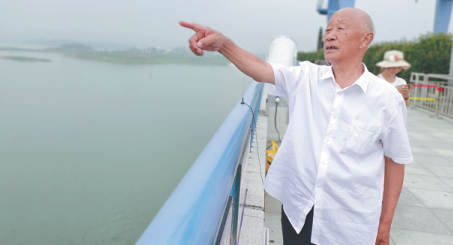Memories flood back for former dam laborer
By ZHAO YIMENG in Danjiangkou, Hubei (CHINA DAILY) Updated: 2019-12-25 00:00A certificate issued six decades ago has made Li Guangyin a celebrity.
The crumpled piece of paper the 77-year-old preserves carefully at the bottom of his closet, read: "Li Guangyin participated in the construction of the Danjingkou Water Conservancy Project and made a contribution to it. He will be reassigned to his hometown on the frontier of agricultural production."
The certificate was awarded by the Danjiangkou Project Bureau in March 1962, when construction of the Danjiangkou Dam was suspended and the workers were all dismissed.
Earlier this year, media were seeking clues about early participants of the project, and Li's certificate was the only one they could find. As a result, Li was invited to revisit the site this year.
So, 57 years after he left the structure at the age of 20, Li stood on the dam in July to view the result of his four years of hardship.
"I'm happy I've lived to see the water in the Danjiangkou Reservoir flowing north to the capital," he said.
In July 1958, the then-16-year-old was dispatched to Danjiangkou with more than 20 other locals to undertake groundwork for the project. Their first task was to cut trees and branches to build shacks in which the workers lived for the following four years.
Two months later, construction started on the Danjiangkou Dam, a major water conservancy project. About 100,000 workers from Hubei and Henan provinces joined the project, carrying clay and gravel to the construction site.
"We worked on the dam's foundation, transporting stones and sediment 12 hours a day. We ate, worked and rested at the construction site from November to May, when the water was less muddy," Li said.
The laborers were divided into three categories. Stone lifters belonged to the first class, earning 32 yuan a month, while the second class carried clay for 30 yuan and the third class dug soil for 28.
Hundreds slept in one big shed. There were no beds, so they lay on straw spread over the ground. They worked in shifts, taking turns to use the simple berths, Li said.
Showers were impossible, he said, so all the workers, both men and women, were covered with lice.
Despite the intensive workload and harsh conditions, the workers were passionate and looked for entertainment through competition. "We set flags on the loads to see which team ran faster. We didn't feel exhausted when our work was like a game," Li said.
The project resumed in 1964, and as machinery was introduced, the number of workers fell to 13,000, mostly technicians.
Li was never called back to the site, so he continued life as a farmer. The elevation of the dam was 162 meters when the concreting process ended in 1973, but it was raised to 176.6 meters in 2009.
Asked why he had preserved the certificate for such a long time, Li gave a simple reason, "It is an important memento."
When there were no other means available for a young man in rural Hubei to record life in the 1950s and '60s, Li's certificate and medical treatment card are the only things to prove he gave four years of his youth to a major project for the country.
Li took his certificate along during his visit, showing it to his grandson and great-grandson, who traveled with him.
Li Chao, his grandson, said: "I never knew my grandfather kept this certificate, though we heard his stories about working on the dam. It is a treasure that carries his generation's spirit, which we will always remember."

- 'Cooperation is complementary'
- Worldwide manhunt nets 50th fugitive
- China-Japan meet seeks cooperation
- Agency ensuring natural gas supply
- Global manhunt sees China catch its 50th fugitive
- Call for 'Red Boat Spirit' a noble goal, official says
- China 'open to world' of foreign talent
- Free trade studies agreed on as Li meets with Canadian PM Trudeau
- Emojis on austerity rules from top anti-graft authority go viral
- Xi: All aboard internet express











